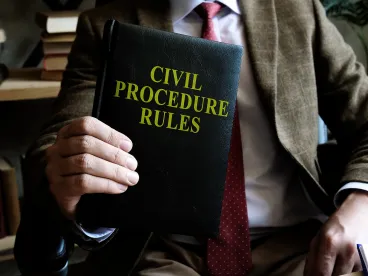Amid the intense coverage of the Colorado ballot exclusion case that was the subject of oral argument before the Supreme Court earlier this month, the Law Court’s decision in Trump v. Secretary of State on a parallel appeal of the Maine Secretary of State’s decision to bar Donald Trump from the ballot has garnered comparatively little notice. The Law Court’s decision has flown under the radar because it does not reach the merits of the meaning and application of the Fourteenth Amendment, but instead turns on appellate procedure. Procedure matters, however, and the decision raises an interesting question.
The challenge to Trump’s primary ballot petition was governed by 21-A M.R.S. § 337, which requires (1) the Secretary to rule on any petition challenge within 5 days of a hearing on the challenge, (2) the Superior Court issue a decision on any appeal within 20 days of the Secretary’s ruling, and (3) the Law Court to issue a decision on any further appeal within 14 days of the Superior Court’s ruling.
Following a hearing, Maine’s Secretary of State determined that Donald Trump was not eligible to appear on the Republican primary ballot in Maine because he is disqualified for the office under Section 3 of the Fourteenth Amendment, but suspended the effect of her decision until the Superior Court reviewed the matter. On appeal, the Superior Court decided to remand the matter back to the Secretary of State. The court noted that the issues presented were soon to be decided by the Supreme Court in Anderson v. Griswold, on appeal of a similar disqualification determination in Colorado. The court noted that all the parties agreed that the Secretary’s stay of her order should remain in place pending the decision in Anderson, and the court was also of the view that a stay was appropriate. Concluding that it was constrained from entering a stay of proceedings in the Superior Court because of the 20-day deadline in Section 337 to issue a decision, the court nevertheless also concluded that a remand would not run afoul of this deadline. Accordingly, instead of staying the appeal, the court remanded to the Secretary with direction to issue a new ruling following the Supreme Court’s issuance of an opinion in Anderson.
This placed the appeal in an odd procedural posture. It is well settled under Maine law that a remand to an agency is not a final judgment subject to appeal because it does not fully decide the case. Likewise, it is well settled that only final judgments are appealable. Thus, when the Secretary appealed the decision, the Law Court asked a reasonable question: should the appeal be dismissed as interlocutory?
After briefing on the issue, the Law Court dismissed the appeal as interlocutory. The Law Court concluded that Section 337 did not specifically authorize interlocutory appeals, and further concluded that no exception to the final judgment rule applied. The judicial economy exception did not apply because a ruling would not result in a final disposition; a decision by the Supreme Court in Anderson might result in reopening the decision. The death knell exception also did not apply, in part because no irreparable harm would follow given that the effect of the Secretary’s decision had been stayed.
The Law Court’s opinion is a straightforward application of well-settled principles of Maine law, but it does not resolve another issue raised by the procedural posture in the case: did the Superior Court have the authority to decline to make a final decision within its statutory deadline? The court concluded that it did have such authority because a remand is a “decision” under 5 M.R.S. § 11007, and therefore a remand satisfies the requirement under Section 337 to render a decision within 20 days. That is a possible reading of the statute, but it is a highly technical one that is at least in some tension with the apparent intent of Section 337—namely, to get final resolution of a ballot challenge on an expedited basis.
A useful contrast can be found in Reed v. Secretary of State, which the Law Court cited as an example of a prior remand by the Superior Court to the Secretary of State. Importantly, in that case, the remand was completed before the expiration of the deadline for the Superior Court to act, which allowed the Superior Court to render a final decision within the statutory deadline. Here, by contrast, the Superior Court expressly remanded the case for further action by the Secretary of State at some unspecified date after all statutory deadlines had passed. The effect of the remand in Trump was therefore very different than the remand in Reed—it allows a ballot appeal to remain unresolved for an indefinite period.
It is an interesting question whether that outcome is consistent with the Legislature’s intent in establishing an expedited timeline for resolving petition challenges under Section 337. And the ramifications of the decision could be more sweeping than the courts intended; it at least suggests that other appeals of determinations by the Secretary of State—such as, for example, appeals relating to initiative and referendum petitions under 21-A M.R.S. § 905—could extend far beyond the deadlines that parties have previously understood to apply. This issue may have to be squarely addressed by the Law Court at some future date, in another appeal.



 />i
/>i

